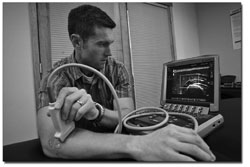|
| ||
| Exercises in healing
by Anna Thomas
Enter Jeff Katz. A couple years ago, Katz, the founder and former CEO of Mercury Payment Systems, was frustrated. Following an injury, he followed the typical road to recovery: chiropractors, doctors, surgeons, massage therapists, one after another. Katz recalls, “There was lots of trial and error and wrong diagnosis, resulting in ongoing pain, exhaustion of insurance benefits, and loss of confidence of recovery.” Finally, he turned to physical therapist Luke Angel, a certified manual therapist. Angel helped Katz recover from his injury using advanced manual therapy techniques, and got to know the guy along the way. One day after mentioning the months of countless visits to the doctor, Katz asked Angel if there was any other way. “Yeah,” Angel had replied, “But it’s expensive.” And just like that, Angel had a benefactor. Over the next year and a half, Katz funded Angel to become educated on the most cutting-edge technology in the physical therapy world, and to bring it home. The result is among the most technologically advanced physical therapy clinics in the nation, right here in little ol’ Durango. Angel, along with his physical therapist wife, Ashlie, opened the doors of Quantified Performance three months ago. “Durango’s a special community because people know how to exercise,” Angel said. “They just need things that push them in the right direction.” That direction takes the form of all manner of new-fangled devices that look like they might have been plucked from the Starship Enterprise. Stopping just short of Bones’ Tri-corder, these machines represent the latest advances in the physical therapy world. At least, the latest advances available to John Q. Public. “It’s been used by the NFL, NHL, the NBA a lot,” says Ashlie, referring to one of the machines. “It just hasn’t really hit the public so much. And now it has.” Among other super-techy tools in Angel’s toolbox is the Real Time Ultrasound. When a patient sees her muscle right there on the screen squirming around with each movement, she can feel and see for herself the right way to do an exercise. Biofeedback like this, says Angel, is an integral part of treatment at his clinic. “Unless you’re showing the person, until they see it on the screen, they’re doing the same thing over and over,” he says. When Angel asked Katz how he could repay him, Katz brushed him off. He told him to use the money to buy more equipment. “This isn’t the end of it,” says Angel. “He wants to make this a true musculoskeletal center.” The model of the clinic is one of cash-based advanced health care. No insurance is accepted, mostly because insurance doesn’t cover the majority of the clinic’s fancy gadgets. “Insurance companies are in the business of not paying. If something new comes out, they want to wait 10, 20 years until there are a thousand studies on it,” says Angel. He is quick to point out, though, that there are volumes of research on the machines in his clinics, and that research has shown a positive effect with good outcomes. In the wake of a 2009 survey published in the journal Health Affairs, which found that physicians spend about 3 hours per week wading through the muck of insurance administration, the question begs asking: is a cash-based health care system better than that of an insurance one?Absolutely, says Angel. “If,” he caveats, “you could get away from the inflated rates that physicians have to charge insurance companies and thus charge individuals.” With treatments that can run anywhere from $40 to $200 a pop, the clinic has no shortage of clientele. That’s how he knows he’s doing a good job, says Angel. People who are paying out of pocket keep coming back. In fact, Katz said he wanted to open this clinic specifically because insurance would not cover the majority of its procedures. “I believed that applying the latest scientific testing methodologies and treatments, regardless of insurance reimbursements, would provide superior outcomes,” says Katz. He envisioned a clinic that “puts patients’ needs first, not the insurance companies.’” •
|
In this week's issue...
- September 11, 2025
- Back on top
After harrowing flying accident, local highliner steps back out with renewed mission
- September 11, 2025
- New order
Rule change for Land and Water Conservation Fund raises alarms
- September 4, 2025
- Armed with knowledge
Local community organizers work to ensure immigrant neighbors know their rights



 What do you get when you combine world class mountain bike trails, stellar backcountry ski terrain, hundreds of gorgeous miles of bikeable open road, and a lot of gnarly people? A lot of gnarly injuries.
What do you get when you combine world class mountain bike trails, stellar backcountry ski terrain, hundreds of gorgeous miles of bikeable open road, and a lot of gnarly people? A lot of gnarly injuries.